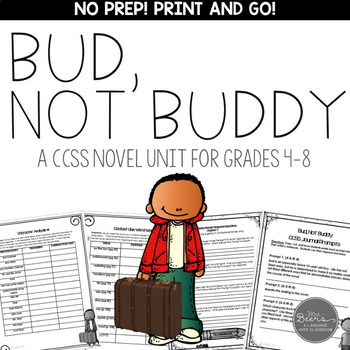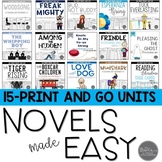Bud, Not Buddy Novel Study Unit CCSS Standards-Based
- Zip
- Google Apps™
- Easel Activity

What educators are saying
Also included in
- If you are looking for the perfect resource to differentiate your reading instruction for grades 4-8, this is the bundle for you!I struggled as a reading teacher to give my students the freedom they need as accountable, independent readers. They needed to be able to grow, self-select novels, and havPrice $70.00Original Price $119.00Save $49.00
Description
Bud, Not Buddy by Christopher Paul Curtis is the perfect novel to share with your students for so many reasons.
This Bud, Not Buddy novel study unit includes both a printable PDF and digital version with everything you need to teach this amazing book while covering your reading literature standards. It includes CCSS lesson plans, comprehension questions, character analysis and vocabulary worksheets, and journal activities.
Summary: Bud is an orphan living at the Home after his mother passed away. For four years he has dreamed of finding his father, but it is after a placement with the Amos family, that Bud takes off on a true adventure to find Herman E. Calloway. Your students will laugh out loud at the adventures of Bud Caldwell and cheer for him as he seeks to find the fairytale ending he has hoped for.
Included in this NO PREP PRINT AND GO novel study:
• Lesson plans for immediate and simple teacher instruction
• Separate PDF and Digital Versions
• 3 Pages of Context Clue Word Work
• 2 Pages for Character Analysis Work
• Main Idea Activity
• 23 Pages of Chapter Reader Response Questions
• Story Map Worksheet
• Figurative Language Activity
• 3 Journal Prompts
• Answer Key
Your upper elementary to middle school students will love this realistic historical fiction novel!
**********************************************************************
**A digital version is also included for use with Google Classroom.**
With the digital version, you have the option to go 100% paperless.
*********************************************************************
Novel not included, but FYI:
Interest Level
Grades 4 - 8
Reading Level
Grade level Equivalent: 5.2
Lexile® Measure: 950L
DRA: 50
Guided Reading: U
Type of Book: Chapter Book
Genre
Historical Fiction
Theme/Subject
Adoption and Foster Care
Parents
African American
Music
Running Away
*********************************************************************
More ELA Resources from Mrs. Beers Language Arts Classroom:
- Reader's Theater for BIG KIDS MEGA BUNDLE
- Editable ELA Word Wall for Middle School
- ELA Emergency Sub Plans Bundle
- Monthly ELA Activities Bundle
- Context Clue Task Cards for Middle School
- Poetry Analysis Resource for Grades 4-8
*********************************************************************
I would love your feedback on this unit. Also be sure to FOLLOW me so that you are aware of any products as soon as they are posted!







